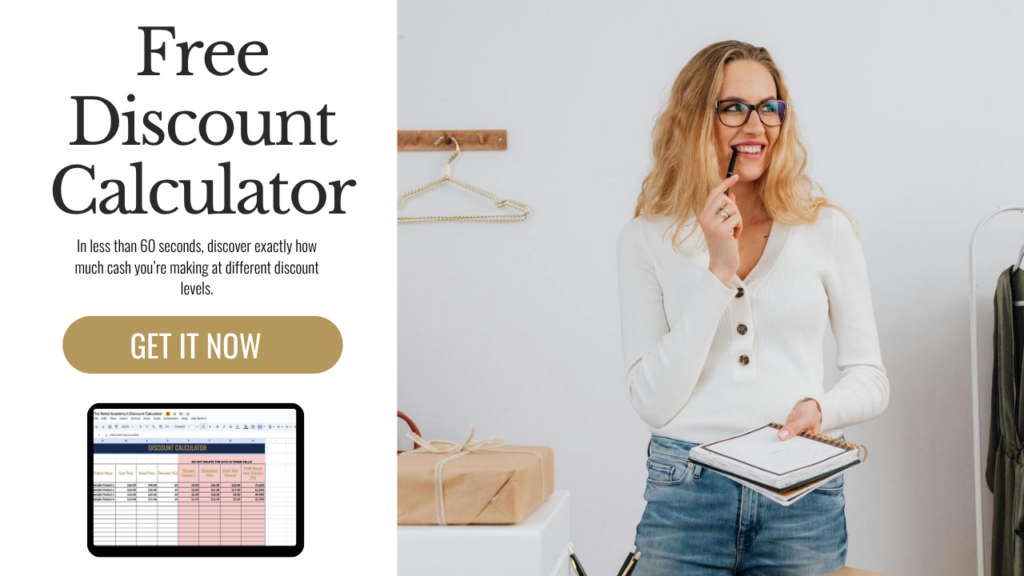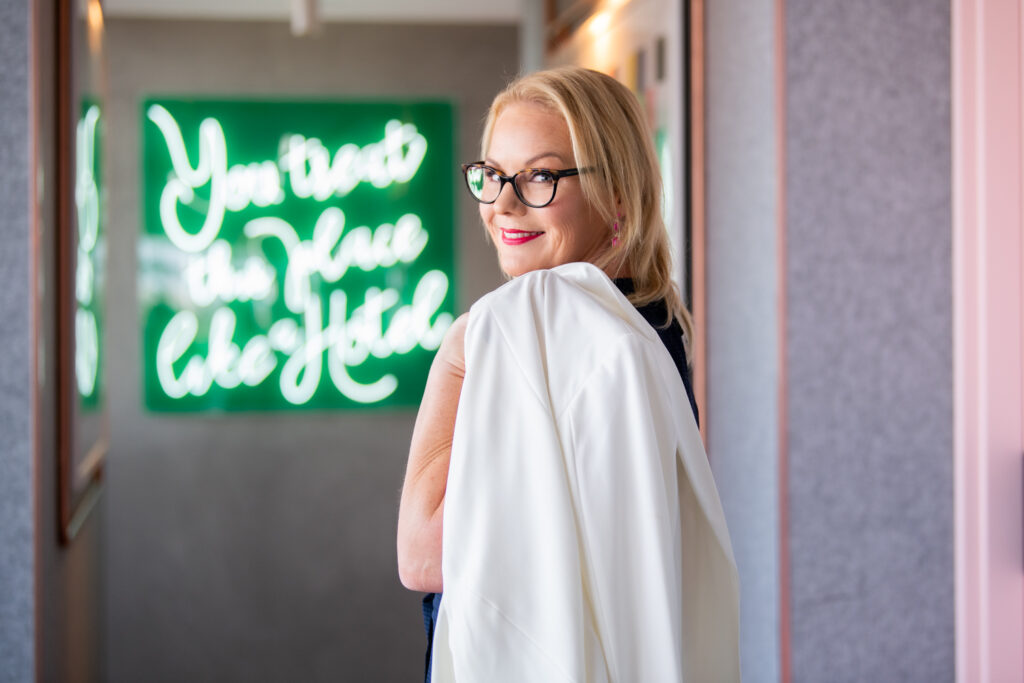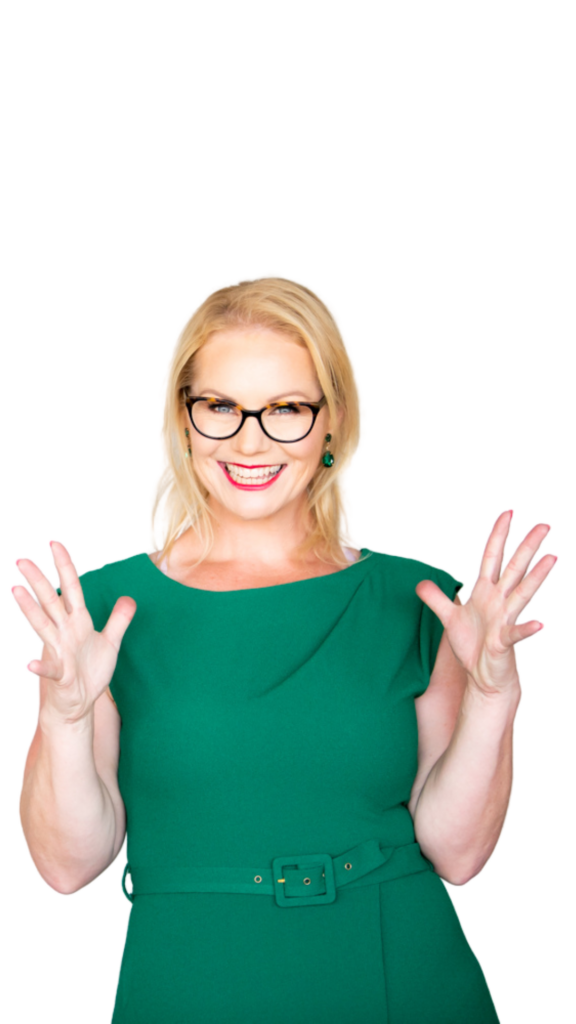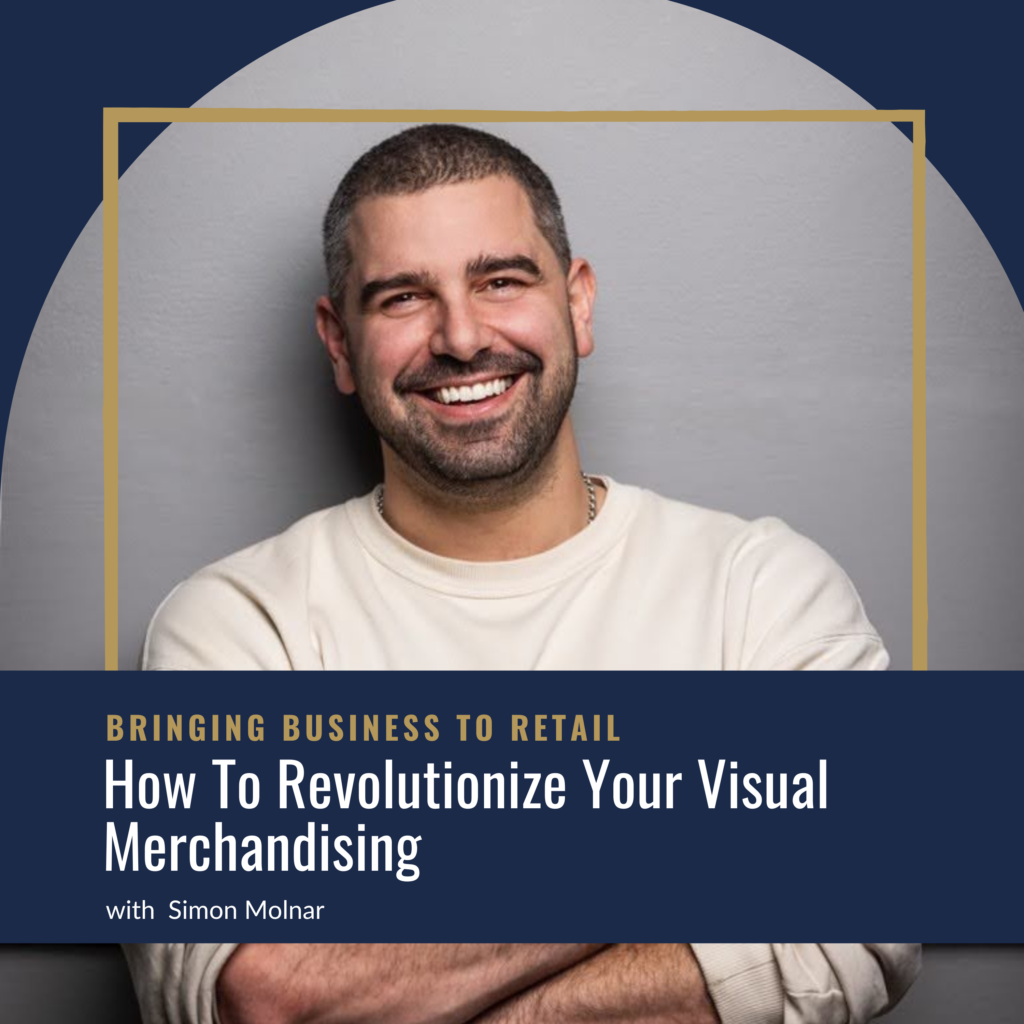
SHOW NOTES
In today’s episode, I’m diving into a question that I get asked all the time by retailers and e-commerce store owners:
“How do I get more people to buy?”
And I get it — more sales feel like the obvious answer when you want to grow. But here’s the thing: getting more traffic isn’t always the fix you think it is.
I’m walking you through five powerful strategies that you can use to increase your conversions and make more money without constantly pouring money into ads or chasing new customers.
Whether you’re making five sales a day or a hundred, there’s something in here for you.
In This Episode, I Share:
- Why focusing on more traffic isn’t the magic solution to more sales
- How I help clients plug the leaks in their sales funnel for instant revenue gains
- Simple ways to increase your Average Order Value (AOV) — often without spending a cent
- How a smoother checkout process can transform your sales
- Why your store’s experience (online and offline) can make or break your conversions
- The trap of selling to the wrong customers — and how to attract the right ones
- How to stop guessing and start making smart, data-driven decisions
So grab a coffee, your notebook, or pop in your earbuds if you’re packing orders, and let’s go!
LISTEN NOW on The Bringing Business To Retail Podcast
[00:00:00] Fixing just one of those things could be the thing that takes your business from where it is now to where you want it to be. And here's the kicker. If you are only doing five sales a day versus a hundred sales a day, ask yourself which one of these is truly going to move the needle in your business?
Because increasing your A OV is probably not going to be it.
Hey there and welcome back to the Bringing Business to Retail podcast. I'm Selena Knight, your retail growth strategist. And if you are here, I already know one thing about you, that you are serious about building a sustainable and profitable brand that doesn't run you into the ground. Today we're diving into one of the biggest questions I get asked from retail and e-commerce business owners.
How do I get more people to buy inside of our scale? Your store accelerated this week. I was asked, not once, but twice. How do I increase my conversions? How do I get more people to buy? And it's an innocent enough question and one [00:01:00] that you really should be thinking about when you're growing your business because after all, more sales is more revenue, right?
And I wish that I could just wave a magic wand and give you the answer, but the simple fact is there isn't just one answer. And anyone who tries to tell you otherwise, they're probably trying to sell you something. But don't worry. I've got you. Because when I do an order of a business, I don't just look at one thing.
I dig into where the biggest gaps are. And let me tell you, most of the time it's not that you need more customers. I mean, you do need to be filling up your customer funnel, but a lot of the times we can get more of our existing people to buy. So. Grab your coffee, your notebook, or just pop in those earbuds if you are packing orders or going for a run or for a walk.
And let's jump in to how you can get more people to buy. When people say that they just need more people to find their store, my first response is, but do you. Because here's the thing, if your [00:02:00] store isn't already converting the traffic that you have, whether it is people coming to your website or people coming to your bricks and mortar store, throwing more people at the store isn't gonna fix the problem.
In one of my recent coaching calls, we ran through the numbers and when we tweaked conversion rates just slightly, the extra revenue that came in far outpaced what getting new customers would've done for that business. Think about it, if only one out of every a hundred people are buying, if you have a 1% conversion rate online, what if you could tweak a few things and get three people out of a hundred to buy instead?
That is literally tripling your revenue without spending a single extra dollar on ads or influencers or affiliates. So before you start spending more money, let's fix what is happening inside of your business. First. When people work with us inside of our five x program, I offer a money back guarantee.[00:03:00]
Now this is tens of thousands of dollars that I personally have to put on the line. And the people that we work with often make their investment back through an increase in revenue, but other times we save them that amount. Usually it's a combination of both. And the truth is, most retail and e-commerce businesses can easily make more money if they look at where the bottleneck is.
So if you are getting traffic, but you're not getting any sales. Then simply spending the time to analyze why something isn't working as well as it could be, tweaking it and testing it will improve your results and it will make or save you money. But what I see is store owners trying to take what they think is the easy way out.
Generally trying to pay someone to fix the problem, but what they're actually paying for is their ignorance or their lack of knowledge, or it's just ego. And whilst they might see an improvement in the short term, because. Pumping more cash into something [00:04:00] is generally gonna make the results look a little bit better in the short term.
If you are giving an ads agency more money, sure you might get more conversions, but at what cost? And so inevitably what ends up happening is all of this comes crashing down and the owner or the founder gets bitter and twisted and assumes they're all agencies, coaches, experts, whatever it was that they invested in.
All of those are a waste of money. Sometimes it is just easier to make more of your potential customers convert. So maybe it's not more customers you need, maybe it's just more revenue per or average order value. So let's say your conversion rate is decent, but the numbers still aren't where you want them, instead of chasing more sales.
What if you just made more money on every sale? One of the things that has happened over the last 12 or 18 months is the economy has tightened, is that the average order value for most people has dropped. And I've seen this across the board, just about every industry. People are [00:05:00] still buying. They're just just not buying as much.
So instead of maybe spending a hundred, they're spending 70. Instead of spending 50, they're spending 30. And so when you are in the thick of it. And your revenue has dropped. It is easy to think if you just got more customers, things would change. And so you take a deep breath, you pull out your credit card and you up your ad spend, and once again, it might work.
Sales hopefully do increase, but your ROAS or your return on ad spend and your profits, they shrink on the backend. You've got more money going out than you have coming into your bank account. What about instead of spending more money on customer acquisition, you looked at the numbers and you realized that if you could just add two, five, $10 to every order, you would have a lot more money in your bank account with no extra ad spend.
Increasing average order value is often the easiest way to increase revenue. It costs nothing. Maybe you might [00:06:00] invest within an app to put cross sells or upsells in place in your business, but you can make more money really, really quickly. The thing is, if you aren't getting the traffic. If you are only getting five people a day to your website, increasing your A OV will bring you in more money.
But the difference is gonna be very negligible. Adding $5 onto every sale when you only have five sales a day is $25, or just on $9,000 a year. But if you have a hundred sales coming in. That is $500 a day or over $180,000 a year, and that makes a big difference, doesn't it? So think about whether are you offering bundles or upsells?
Can you increase your prices? Are you making it easier for people to spend that little bit more? Because remember, it's way easier to get someone who's already, who's already ready to buy. To add one more thing to their cart than it is to convince someone who's never met you before [00:07:00] to shop with you to give you their money.
So recapping. So far, we're looking at fixing the leaks in our conversion process, and then we increased how much our customers are going to spend with us. So that's the first two. The third way to get more people to buy without getting more people is to make checkout so easy. It is a no brainer. Alright.
So you look at the numbers and maybe people are adding to their cart, but they're ghosting you before checkout. This is where I'd be asking what is stopping them from hitting that buy now button? What is stopping them from hitting confirm order? And we've all done it. We browse, we add to cart, and then something distracts us.
The dog barks, A text comes in. You have to get up and find your wallet, and all of a sudden that thing that you were about to buy just isn't that urgent anymore. If your checkout process is clunky or overwhelming, you are losing customers who are ready to buy. Oh my gosh. My local [00:08:00] grocery chain that I get my groceries delivered from, they have upsells in place at checkout.
So you go to cart and it says, Hey, have you forgotten something? And it pops up things that you've bought from before. You either click out or you add to cart and then you go through and you put your details in, you put your credit card in, and you click confirm. But then you have to wait and click a button that says, place order.
And I can't tell you how many times I've waited for my grocery delivery only to find it's not coming because I forgot to click that extra button. So if you are making your checkout process difficult. You will lose customers and you will lose sales. You'll lose those people who are ready to give you money.
So think about it. Does your store offer one Click checkout? Apple Pay, Google Pay. My gosh, apple Pay has been a lifesaver for me. And I am so quick to spend, if I can double click the button and choose my card. When you look at your store, are you making people enter their shipping address, their billing [00:09:00] address, their phone number, and create an account Just to be able to check out, have you looked at where people are abandoning their cart?
Is your checkout too clunky? Are there too many steps? Make it seamless, my friend. Make it easy. Make it so simple that clicking buy is the most obvious thing for them to do. When we worked with one. E-commerce lingerie. It was an e-commerce lingerie retailer. We made that one change. Streamlining her payment options by adding Apple Pay and Google Way, Google Pay, and bang, 21% increase in car checkouts.
Amazing. Think of what that does to your bottom line. Think of your checkout like a slippery dip, not an obstacle course. The fewer bumps and friction points that there are, the more that sales are gonna slide right in. So we fixed the leaky bucket. We've gotten our customers to spend more. We have made it easier for them to check out and give us money.
What's next? My fourth way that you can get [00:10:00] more people to buy. Is thinking about whether your store actually makes people want to buy, because sometimes it isn't about pricing or technology, it's about the experience. Fun story. My brother-in-law loves to dabble in E-com. Sometimes his little ventures work out, sometimes they don't.
He just does it for fun. My sister is a nurse, and so my brother realized that there was this distinct lack of cute scrubs here in Australia. And so as he does, he jumped on Alley Express, he created a drop ship site, and he started selling cute scrubs. And you know what the bad, you know the bad mind boggling.
I know it's bad, but the mind boggling thing is he does okay with it. The thing is, when I went to his website, because you know me, I'm gonna go there and snoop around, but when I got to his website, I went, whoa. This website looks like a scam. The pictures are clearly of Ali Express or Temu or something like that, which means even if [00:11:00] this isn't a scam site, the products are probably gonna be cheap, Chinese crap that will probably fall apart in the wash.
The logo was so bad. The pictures were all different sizes because they were just pulled in from Ali Express. Some of them were pixelated. There were different types of models. There was no cohesion. There was no about page. I literally sent him a message saying, Davo, do you really get sales from this site?
All the power to you? Because there is no way I would put my credit card details into it. Alright. I call a spade a spade. He's my brother-in-law. We love each other and he's totally cool with it. But fair play to him. He has taken none of my advice, advice, but he still gets sales through that site. But I think he could be doing a lot more.
Similarly, I still remember the day in my store. I remember it vividly, what is it, nearly 20 years later, that I watched a woman walk back and forth in front of the plate glass windows, and she finally came in the door and she said, am I in [00:12:00] the right place? And she was, but my store didn't match up with what was online.
So think about if you sell premium products, does your branding match? Is the way that you are showing up online? In your socials, in your emails, is it in a way that your best customers would associate with your brand? Because I clearly got it wrong in the beginning. I mean, you are never going to see an unpolished image on a Louis Vuitton Instagram feed.
Even if you search behind the scenes, which I did. Every piece of content is artfully crafted, and that's because the people shopping there are either artfully crafted themselves or they aspire to portray that. In my store example, my online store was very chic, modern, lots of white space, beautiful images, easy to navigate.
But my store, because I sold Eco baby products, was more shabby [00:13:00] chic. It was the style at the time. Okay. I thought that store experience was more in line with what people would expect from eco products, but there was a mismatch and the disconnect was confusing to customers. I'm gonna say this was my first real life experience with brand cohesion because it never occurred to me that my website should look to my look like my store.
And remember at this point, I had a marketing degree. I had a business degree with marketing experience. I should have known this stuff, but I didn't because they didn't teach me that in university. And I'd never really sat there and thought about it. Remember, this was the beginning of e-commerce. This was.
Back in 2007, 2008, when e-commerce was still new and we were on the cutting edge of making sure we even had websites, so I'm proud of that. But I was not proud of the disconnect. But it's not always your brand. Sometimes it's a physical thing. If you have a bricks and mortar store, if [00:14:00] you have a poor store layout or if you have a poor website navigation, it could be a physical barrier to buying rather than that subconscious barrier where the woman walked in the door and didn't think she was in the right place.
When someone lands on your website, do they instantly get why they should be there, why they should be buying from you? Does your brand stand out or does it just blend in? Are your product descriptions making people feel something, or are they just a list of features or something that you copied and pasted from the manufacturer's website?
So step back, take a look at your store, like a customer, walk in their shoes. Does your store, whether it's online, in person, or both, as my case was. Make them want to pull out their credit card. Okay? If you are new to the show, you just got a dose of real talk sale. No fluff, no bs. Straight to the point.
Alright, so how do we find the fix? So far, we've looked at focusing on actively fixing our leaky bucket, actively increasing [00:15:00] conversions rather than spending more money on driving traffic to your store, increasing your average order value. We got all the way to cart and looked at what might be stopping people from giving you their money.
We just talked about those disconnects. Whether your store makes someone want to buy, not my brother-in-law's store. Or if it does, and sometimes it's a physical sense and sometimes that's subconsciously. Alright, we are up to number five. This is my last point. Okay. If you're sticking with me. Thank you so much.
So let's jump into the fifth way that we can get more people to buy without getting more people. So inside of my scale store accelerator. We help you finally figure out why your store isn't growing and exactly how to fix it. And one of the revelations that I'm seeing is that too often we settle for the wrong people, and that includes our customers.
And I get it. When you are starting out or if your sales have dropped, you are desperate and you will take anyone's [00:16:00] money, and that is survival. But there comes a point where you have to move past this. Because if you are starting to change your product mix in an attempt to keep those low spending customers, or you don't understand your customer acquisition costs, so you pull back on specific ad campaigns or ad channels, because on the surface it looks like those customers cost more, but you haven't analyzed on the back end how much they're worth to you.
That is when you can end up in this trap. So when it comes to increasing conversions, a question you need to ask yourself is, are you even attracting the right people? If you're running ads or promotions that bring in bargain hunters, but your business is built on premium products, so shoppers are never going to convert.
And if they do, they're the ones who ask for refunds, leave bad reviews, or just drain your energy and probably your bank account. So instead. Take a deep breath, and instead of trying to sell to everyone, focus on bringing in the people [00:17:00] who actually want what you offer. The people who are excited to buy and won't hesitate to click the checkout button.
And the funny thing is, if you start marketing to those customers by default, better customers come along for the ride. And those crappy customers, well, they'll find a new discount store to answer their dms at 11:00 PM not you. So what's your next step? I've just walked you through five different ways that you can increase your conversions and get people to buy more without getting more people.
So we're looking at actively fixing our leaky bucket, fixing our conversion rate, rather than spending more money on driving more traffic, increasing your average order value. Then we got all the way to the car and looked at what might be stopping people from giving you their money. Think about this in a physical sense as well.
I know the example I gave was an e-commerce example, but think about that in store as well. Do you make it easy for people to buy? Do you make it easy for people to see where they're supposed to spend their money? Do you have those point of sale [00:18:00] really clearly laid out, and is it warm and inviting? We talked about disconnects.
Whether your store makes someone want to buy, either in a physical sense or subconsciously. And lastly, focusing on those better quality customers. I call them your customer royalty, the ones that bring in the 80% of your revenue rather than the discount hunters who are going to take up your bandwidth and give you pennies in return.
Fixing just one of those things could be the thing that takes your business from where it is now. To where you want it to be. And here's the kicker. If you are only doing five sales a day versus a hundred sales a day, ask yourself which one of these is truly going to move the needle in your business?
Because increasing your A OV is probably not going to be it. Maybe the answer is yes, maybe the $25 a day is what your business needs, but if you're looking to grow, the answer is probably no. At different stages in business, what's holding you back Changes. And in the beginning it's generally volume. [00:19:00] You need to put more effort in to get more people to know that you exist.
And as you grow, profit might be your sticking point. I've seen businesses doing $6 million in turnover with no money left over at the end of the year. Getting more customers isn't that company's sticking point. It's access to cash. And so this is where so many people come undone. They listen to a podcast like this.
They get advice from a friend or a coach, and they, they see somebody else who's done something that they think is successful, and they talk about what they take, what they did, and they put it in their business. They put a lot of energy and money trying to replicate something because they're always trying to find that shiny new thing that's trying to propel their business forward.
And maybe that thing will be the thing that your business needs. But if it isn't. All that focusing on the wrong thing does, or even worse doing nothing. All that does is compounding the time it takes to get you to where you want to be. It's opportunity cost. What you do, the path you choose is at the [00:20:00] expense of something else.
So here's what I want you to do. Before you put all of those things or any of those things in place, think about what is really holding your business back. Is it cash? Is it customers? Is it operations? Or are you simply not growing because you are doing all of the things and you are stretched to the max?
More money is not going to fix that unless the plan is to use that money to hire more staff. And likewise, more staff is not going to fix your business if you have no customers. So look at your business and then if you need to increase your conversions, look at your numbers. Where are people dropping off?
What's already working that you can do more of? Tweak, test, refine, document, and keep moving forward and to make this easier. I have got something free for you. It is my profit calculator. It is gonna help you plug in your numbers and it will literally show you exactly how much more revenue and profit you could be generating by [00:21:00] either getting more customers, adjusting your pricing, or tweaking some of those other strategies.
So grab it now and start making data driven decisions that will actually move your business forward. It is totally free. And you can get it over at selena knight.com/calculator. Alright, that is a wrap for today. If this episode gave you a little bit of an aha moment, please take your screenshot, share it on Instagram, tag me at the Selena Knight, and I would love to hear what clicked for you.
Until next time, keep growing, keep optimizing and keep making money. So that's a wrap. I'd love to hear what insight you've gotten from this episode and how you're going to put it into action. If you're a social kind of person, follow me at the Selena night and make sure to leave a comment and let me know.
And if this episode made you think a little bit differently or gave you some inspiration, or perhaps gave you the kick that you needed to take action, then please take a couple of minutes to leave me a review. [00:22:00] On your platform of choice because the more reviews the show gets, the more independent retail and e-commerce stores just like yours, that we can help to scale.
And when that happens, it's a win for you, a win for your community, and a win for your customers. I'll see you on the next episode.
Share this episode
Watch The Video











